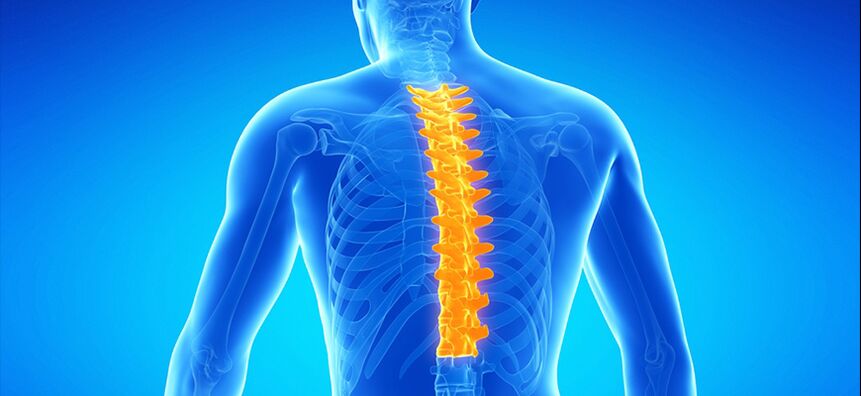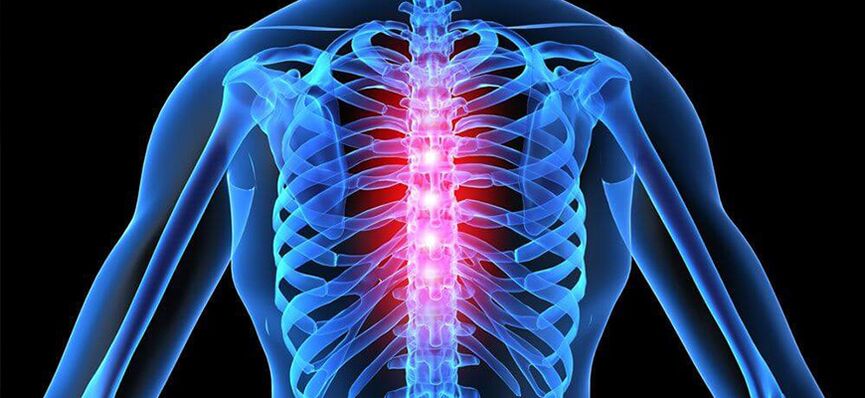
Thoracic osteochondrosis is quite a dangerous pathology, which is explained by the difficult process of its diagnosis. Therefore, it is often only possible to identify the disease in advanced stages. Initially, osteochondrosis of the thoracic spine was considered a disease of the elderly, but recently there has been a clear trend towards a significant "rejuvenation" of this disease, so it is important to know the main symptoms and treatment. in order to improve the clinical picture of the disease.
The complexity of the diagnosis is due to the fact that the vertebrae located in the thoracic region are the least susceptible to stress and injury. However, reduced mobility is not a guarantee of safety, therefore the occurrence of pathologies in this department is also very common. As statistics show, this disease is not directly related to the aging process and gender.

Specificity of the disease
This disease is characterized by pathological processes that lead to negative changes in the structure of tissues. As a result, the destruction of the fibrous ring of the intervertebral disc itself can occur and, as a result, the protrusion of the nucleus pulposus. This condition is dangerous because there is a risk of spinal cord compression and further disability of the person.
The progression of the disease in childhood can lead to premature aging of the musculoskeletal system even before its final formation. That is why, it is extremely important to quickly diagnose the pathology at an early stage, when the destruction of the vertebrae and adjacent tissues has not yet taken place.
Clinical symptoms
This disease manifests itself in completely different ways, depending on the stage. Therefore, we will highlight the general symptoms of osteochondrosis of the thoracic spine:
- Pain. It can occur not only when performing actions, but also during a prolonged stay in static positions.
- Stiffness of movement that interferes with the free rotation of the body.
- Shortness of breath, caused by a feeling of strong pressure in the middle of the back.
- Problems with the functioning of the gastrointestinal tract and other internal organs.
Very often the disease is manifested by painful sensations on the left side of the chest, which can be interpreted as a symptomatology of heart pathologies. This complicates the diagnosis, but the specialist assesses all the patient's complaints, which makes it possible to correctly interpret all the existing symptoms.
Knowing the symptoms of osteochondrosis of the thoracic spine, you can quickly seek qualified help. We recommend that you pay more attention to the signals your body is giving.

When making a diagnosis, it is important to know how osteochondrosis of the thoracic region manifests itself, since this disease is insidious, so it is easy to confuse it with other diseases. Depending on the nature of the pain, the main types of osteochondrosis of the thoracic spine can be distinguished. One condition is characterized by prolonged pain in the damaged area of the spine, and the second is characterized by the appearance of sharp attacks, literally restraining the movements of a person, which makes their respiratory functions difficult.
Causes of the disease
The following causes of osteochondrosis of the thoracic spine can be distinguished:
- Pathological processes that negatively affect the structure of the discs. In particular, there is a certain genetic predisposition to this disease.
- The lack of activity associated with the performance of their work functions and the peculiarities of leisure activities.
- Scoliosis, which causes increased stress on parts of the spine.
- Mechanical damage to the chest.
- Muscle training associated with lifting heavy loads.
- Regular stressful situations.
- Hypothermia of the body.
- Lack of calcium.
- Hormonal disturbances.
Classification of the disease
Intervertebral osteochondrosis of the thoracic spine develops in stages, each characterized by its own negative manifestations:
- First degree. The initial stage of osteochondrosis of the thoracic region is characterized by a condition where there is a loss of moisture from the intervertebral disc. Elasticity decreases, painful sensations of low intensity appear, which completely disappear when a person adopts a comfortable posture.
- Second degree. The disc continues to lose moisture. As a result, it becomes smaller, cracks appear, some of them are quite deep. The muscle corset tries to adapt, trying to maintain the stability of the spine, resulting in severe spasms and pain in the back, chest and limbs.
- Third degree. At this point there is a breakthrough of the nucleus pulposus outward. Basically, it is an intervertebral hernia in which the pain persists throughout the day. A person is forced to change the type of activity for one in which the discomfort will not be so intense.
- Fourth degree. Prolonged osteochondrosis of the thoracic spine is dangerous, because at the site of the injury serious restructuring of all tissues begins to occur. There is a natural replacement of the fibrous ring tissue with bone, resulting in severe stiffness of movement. We also observe the appearance of osteophytes, a deformation of the spine.
Period of exacerbation

The manifestation of osteochondrosis of the thoracic region at the stage of exacerbation is characterized by the appearance of paroxysmal pain, which is extremely difficult to relieve with improvised means. Self-medication at this stage is unacceptable, so you should urgently consult a doctor or call for help for pain relief.
Only a neurologist can correctly interpret your complaints, prescribing an appropriate follow-up examination and treatment. During an exacerbation, it is extremely important to relieve the patient's condition.
An exacerbation of the disease can be caused by a variety of factors, including stressful situations, hypothermia, and activities associated with intense loads. In this condition, a significant deterioration in the well-being of the patient is observed, breathing may be difficult, and mobility may be limited. In some cases, hospitalization may be necessary.
Basic diagnostic methods
Signs of osteochondrosis of the thoracic spine are the appearance of pain of different localization, stiffness of movement, as well as difficulty in breathing. The complexity of the diagnosis lies in the fact that a large number of diseases of various kinds correspond to this description. In particular, there is such a concept - the "gastrological syndrome", which is characterized by the appearance of pain in the epigastrium, which can be wrongly interpreted as manifestations of gastritis or other diseases of the gastrointestinal tract.
Only modern diagnostic methods will make it possible to make an accurate diagnosis, on the basis of which the neurologist will prescribe the appropriate treatment. It all starts with a detailed patient interview, clarification of existing complaints and associated diseases.
After collecting the history, the doctor directly conducts the examination himself with special tests. Then the patient should undergo the necessary laboratory tests, as well as x-rays and MRI scans. Magnetic resonance imaging allows you to study the condition of the spine in more detail, identify existing pathologies, the size and location of the hernia (if any).
How is the treatment process going?
It is extremely important to know what to do with osteochondrosis of the thoracic region. After confirming the diagnosis, the doctor prescribes an individual treatment regimen for the patient. It is necessary to take into account the age and the presence of concomitant diseases, as well as allergies to certain drugs.
At the first stage, treatment is carried out with the help of various drugs: nonsteroidal anti-inflammatory drugs, analgesics and antispasmodics.
The main goal at this stage is to relieve the patient's condition, reduce the pain syndrome and muscle tissue spasms. In particularly severe cases, when immediate relief of acute pain is needed, analgesic blockages are used.
Local agents in the form of ointments and gels can also be used, but their effectiveness is somewhat lower, due to the difficulty of delivering active substances to the lesions.
In general, the treatment of osteochondrosis of the thoracic spine is an integrated approach that combines the use of several methods at the same time. Only such therapy can give not a one-time positive result, but an improvement in the clinical picture over time.
Physiotherapy
Physiotherapy is performed after the pain has been relieved. It is extremely important to perform all movements slowly, avoiding sudden movements, in order to avoid a deterioration of the condition.
Remember, if exercising is causing you pain, stop immediately and see a doctor.
Massage procedures

Muscle spasms, hypertonia, pain - this is how osteochondrosis of the thoracic spine manifests itself. To eliminate these symptoms, massage can be used, which should be performed by a qualified professional. These procedures can be used not only for therapeutic purposes, but also as a good preventive measure.
Prophylaxis
The consequences of osteochondrosis of the thoracic spine will not be so strong if you strictly follow certain medical recommendations. If a specialist has prescribed bed rest for you, then in no case should you ignore it, otherwise your condition may worsen. A person should be limited to physical activity, therefore, he will have to refuse to go to the gym, to work with weights.
An important part of primary prevention is the early identification of people during medical examinations who have initial signs of osteochondrosis of the thoracic spine. Another no less important point is good nutrition, which involves avoiding certain foods. It is necessary to limit the use of salt, so smoked meats, various spicy spices and pickles will have to be removed from the diet.
It is very important to use drugs with chondroprotective action, which slow down the progression of osteochondrosis of the thoracic spine, nourish and improve metabolic processes in cartilage tissue.
Conclusion
Thoracic osteochondrosis of the spine can be treated. In order for this to be possible, you should strictly follow the recommendations of the attending physician and adhere to the established treatment regimen. The initial osteochondrosis of the thoracic spine is best treated, so it is extremely important to pay more attention to your body, responding to the slightest symptoms of the disease.
To avoid a possible relapse, you need to take preventive measures, monitor your posture, which is especially important during sedentary work. Contact only qualified doctors, because only they will be able to prescribe a competent treatment regimen and subsequent recovery.



































